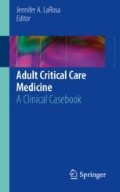Abstract
Sepsis is defined as life-threatening organ dysfunction caused by a dysregulated host response to infection according to the 2016 Sepsis-3 consensus statement. The diagnosis of septic shock additionally requires hypotension despite adequate fluid resuscitation and high lactate. The diagnosis of sepsis requires both a suspected infection and signs of organ dysfunction. It is a very common cause of hospitalization and death. Management strategies include (1) early adequate antimicrobials, (2) aggressive resuscitation, (3) timely source control, (4) adjunctive therapies, and (5) appropriate de-escalation of therapies once the patient has stabilized.
Access this chapter
Tax calculation will be finalised at checkout
Purchases are for personal use only
References
Angus DC, Linde-Zwirble WT, Lidicker J, Clermont G, Carcillo J, Pinsky MR. Epidemiology of severe sepsis in the United States: analysis of incidence, outcome, and associated costs of care. Crit Care Med. 2001;29:1303–10.
Kadri SS, Rhee C, Strich JR, Morales MK, Hohmann S, Menchaca J, et al. Estimating ten-year trends in septic shock incidence and mortality in United States academic medical centers using clinical data. Chest. 2017;151(2):278.
Singer M, Deutschman CS, Seymour CW, Shankar-Hari M, Annane D, Bauer M, et al. The third international consensus definitions for sepsis and septic shock (sepsis-3). JAMA. 2016;315(8):801–10.
Kaukonen KM, Bailey M, Pilcher D, Cooper DJ, Bellomo R. Systemic inflammatory response syndrome criteria in defining severe sepsis. N Engl J Med. 2015;372(17):1629–38.
Atkinson PR, McAuley DJ, Kendall RJ, et al. Abdominal and cardiac evaluation with sonography in shock (ACES): an approach by emergency physicians for the use of ultrasound in patients with undifferentiated hypotension. Emerg Med J. 2009;26:87–91.
Perera P, Mailhot T, Riley D, Mandavia D. The RUSH exam: rapid ultrasound in SHock in the evaluation of the critically lll. Emerg Med Clin North Am. 2010;28:29–56, vii.
Tang BM, Eslick GD, Craig JC, McLean AS. Accuracy of procalcitonin for sepsis diagnosis in critically ill patients: systematic review and meta-analysis. Lancet Infect Dis. 2007;7(3):210.
Suetrong B, Walley KR. Lactic acidosis in Sepsis : it’s not all anaerobic: implications for diagnosis and management. Chest. 2016;149(1):252–61.
Casserly B, Phillips GS, Schorr C, Dellinger RP, Townsend SR, Osborn TM, et al. Lactate measurements in sepsis-induced tissue hypoperfusion: results from the surviving sepsis campaign database. Crit Care Med. 2015;43(3):567.
Kumar A, Roberts D, Wood KE, Light B, Parillo JE, Sharma S, et al. Duration of hypotension before initiation of effective antimicrobial therapy is the critical determinant of survival in human septic shock. Crit Care Med. 2006;34(6):1589–96.
Seymour CW, Gesten F, Prescott HC, Friedrich ME, Iwashyna TJ, Phillips GS, et al. Time to treatment and mortality during mandated emergency care for sepsis. N Engl J Med. 2017;376:2235–44.
Kanji Z, Dumaresque C. Time to effective antibiotic administration in adult patients with septic shock: a descriptive analysis. Intensive Crit Care Nurs. 2012;28(5):288–93.
Paul M, Shani V, Muchtar E, et al. Systematic review and meta-analysis of the efficacy of appropriate empiric antibiotic therapy for sepsis. Antimicrob Agents Chemother. 2010;54:4851–63.
Kumar A, Zarychanski R, Light B, Parrillo J, Maki D, Simon D, et al. Early combination antibiotic therapy yields improved survival compared with monotherapy in septic shock: a propensity-matched analysis. Crit Care Med. 2010;38(9):1773–85.
Rhodes A, Evans LE, Alhazzani W, et al. Surviving sepsis campaign: international guidelines for management of sepsis and septic shock: 2016. Intensive Care Med. 2017;43:304.
Rivers E, Nguyen B, Havstad S, et al. Early goal-directed therapy in the treatment of severe sepsis and septic shock. N Engl J Med. 2001;345:1368–77.
The Arise Investigators and Anzics Clinical Trials Grou. Goal-directed resuscitation for patients with early septic shock. N Engl J Med. 2014;371:1496. https://doi.org/10.1056/NEJMoa1404380.
ProCESS Investigators. A randomized trial of protocol-based care for early septic shock. N Engl J Med. 2014;371:1683–93.
Mouncey PR, Osborn TM, Power GS, et al. Trial of early, goal-directed resuscitation for septic shock. N Engl J Med. 2015;372:1301–11.
Bloos F, Thomas-Rüddel D, Rüddel H, et al. Impact of compliance with infection management guidelines on outcome in patients with severe sepsis: a prospective observational multi-center study. Crit Care. 2014;18:1.
Parrillo JE, Dellinger RP. Critical care medicine: principles of diagnosis and management in the adult. 4th ed. Philadelphia: Elsevier; 2014.
Author information
Authors and Affiliations
Editor information
Editors and Affiliations
Rights and permissions
Copyright information
© 2019 Springer International Publishing AG, part of Springer Nature
About this chapter
Cite this chapter
Kumar, A., Tremblay, V. (2019). Sepsis and Septic Shock. In: LaRosa, J. (eds) Adult Critical Care Medicine. Springer, Cham. https://doi.org/10.1007/978-3-319-94424-1_8
Download citation
DOI: https://doi.org/10.1007/978-3-319-94424-1_8
Published:
Publisher Name: Springer, Cham
Print ISBN: 978-3-319-94423-4
Online ISBN: 978-3-319-94424-1
eBook Packages: MedicineMedicine (R0)

